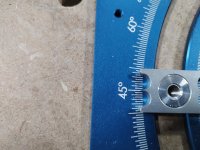wriv said:How snugly do everyone else's dogs fit in their PGS produced dog holes? Are my expectations the problem or is there some other factor I'm failing to account for?
Thanks in advance for any ideas or suggestions!
Will
Hello all,
I realize this is an old thread but stumbled upon it because I'm having the exact problem. I would like to see your videos to compare but they appear to be dead links. Below is a link to a short Youtube video which I hope illustrates my issue...
- I'm using a "pecking" motion.
- Also tried different materials with same results.
- I didn't think to do it in the video, but I also inserted the dog upside down
all the way through the hole, so it's more than fully seated. It still wobbles.
- I flooded the holes with a very thin sealer (Flood Penetrol) hoping to swell them tighter. No difference.
I sent that video to Axminster a few days a go but haven't heard back. TSO is sending me a new cutter free
of charge. Very nice of them!
I've just completed my first MFT style top and feel very disappointed. Dogs which I need to guide my rail lean
over at the top at least a mm in either direction. I could purchase star knobs to screw them in from the bottom
but reaching under the table to set up and un-do operations fumbling with knobs shouldn't be necessary.
Has anyone confirmed the source of the problem... an out of spec cutter diameter, or a non-concentric spike?
Any thoughts would be appreciated.



